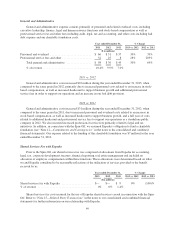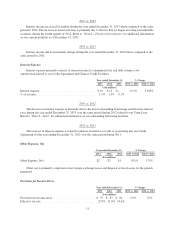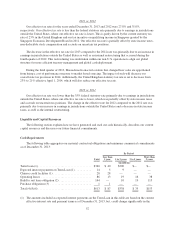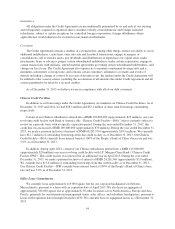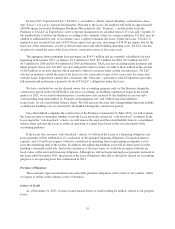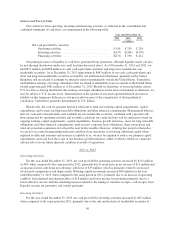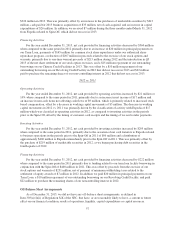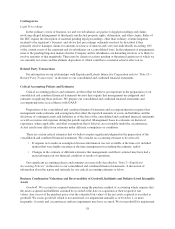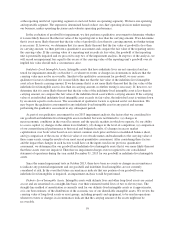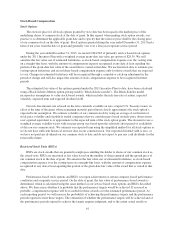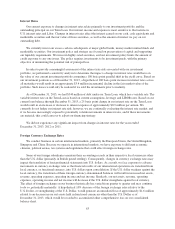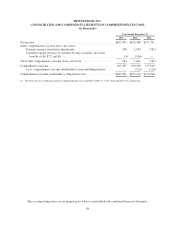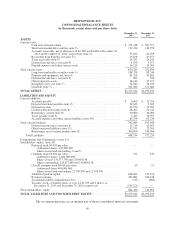TripAdvisor 2013 Annual Report Download - page 69
Download and view the complete annual report
Please find page 69 of the 2013 TripAdvisor annual report below. You can navigate through the pages in the report by either clicking on the pages listed below, or by using the keyword search tool below to find specific information within the annual report.at the reporting unit level (operating segment or one level below an operating segment). We have one operating
and reportable segment. The segment is determined based on how our chief operating decision maker manages
our business, makes operating decisions and evaluates operating performance.
In the evaluation of goodwill for impairment, we first perform a qualitative assessment to determine whether
it is more likely than not that the fair value of the reporting unit is less than the carrying amount. If we determine
that it is not more likely than not that the fair value of goodwill is less than its carrying amount, no further testing
is necessary. If, however, we determine that it is more likely than not that the fair value of goodwill is less than
its carrying amount, we then perform a quantitative assessment and compare the fair value of the reporting unit to
the carrying value. If the carrying value of a reporting unit exceeds its fair value, the goodwill of that reporting
unit is potentially impaired and we proceed to step two of the impairment analysis. In step two of the analysis, we
will record an impairment loss equal to the excess of the carrying value of the reporting unit’s goodwill over its
implied fair value should such a circumstance arise.
Indefinite-Lived Intangible Assets. Intangible assets that have indefinite lives are not amortized and are
tested for impairment annually on October 1, or whenever events or changes in circumstances indicate that the
carrying value may not be recoverable. Similar to the qualitative assessment for goodwill, we may assess
qualitative factors to determine if it is more likely than not that the fair value of the indefinite-lived intangible
asset is less than its carrying amount. If we determine that it is not more likely than not that the fair value of the
indefinite-lived intangible asset is less than its carrying amount, no further testing is necessary. If, however, we
determine that it is more likely than not that the fair value of the indefinite-lived intangible asset is less than its
carrying amount, we compare the fair value of the indefinite-lived asset with its carrying amount. If the carrying
value of an individual indefinite-lived intangible asset exceeds its fair value, the individual asset is written down
by an amount equal to such excess. The assessment of qualitative factors is optional and at our discretion. We
may bypass the qualitative assessment for any indefinite-lived intangible asset in any period and resume
performing the qualitative assessment in any subsequent period.
As part of our qualitative assessment for our 2013 impairment analysis, the factors that we considered for
our goodwill and indefinite-lived intangible assets included, but were not limited to: (a) changes in
macroeconomic conditions in the overall economy and the specific markets in which we operate, (b) our ability
to access capital, (c) changes in the online travel industry, (d) changes in the level of competition, (e) comparison
of our current financial performance to historical and budgeted results, (f) changes in excess market
capitalization over book value based on our current common stock price and latest consolidated balance sheet,
and (g) comparison of the excess of the fair value of our of trade names and trademarks to the carrying value of
those same assets, using the results of our most recent quantitative assessment. After considering these factors
and the impact that changes in such factors would have on the inputs used in our previous quantitative
assessment, we determined for our goodwill and indefinite-lived intangible assets that it was more likely than not
that these assets were not impaired. Therefore no impairment charges were recognized to our consolidated
statement of operations during the year ended December 31, 2013 for our goodwill or indefinite-lived intangible
assets.
Since the annual impairment tests in October 2013, there have been no events or changes in circumstances
to indicate any potential impairment and our goodwill and indefinite lived intangibles are not currently
considered at risk. In the event that future circumstances indicate that any portion of our goodwill or our
indefinite-lived intangibles is impaired, an impairment analysis would be performed.
Definite-Lived Intangible Assets. Intangible assets with definite lives and other long-lived assets are carried
at cost and are amortized on a straight-line basis over their estimated useful lives of two to eleven years. The
straight-line method of amortization is currently used for our definite-lived intangible assets as it approximates,
or is our best estimate, of the distribution of the economic use of our identifiable intangible assets. We review the
carrying value of long-lived assets or asset groups, including property and equipment, to be used in operations
whenever events or changes in circumstances indicate that the carrying amount of the assets might not be
recoverable.
59


